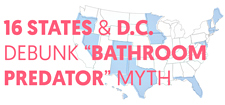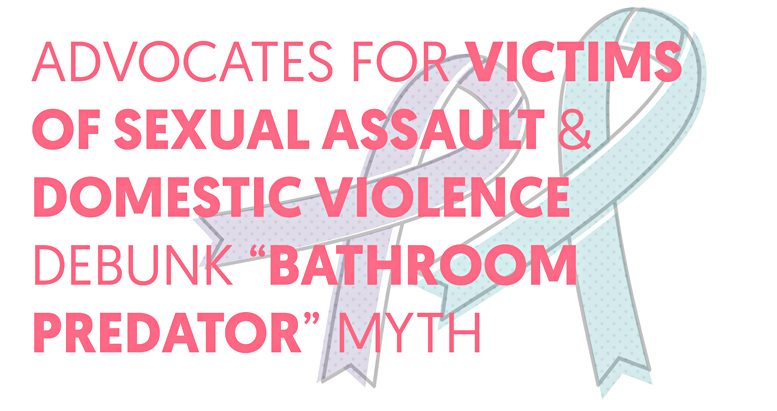Today, Media Matters released the definitive guide to the “bathroom predator” myth that has been repeatedly debunked—by experts and government officials in 16 states and the District of Columbia, and school administrators in 23 school districts and four universities who serve an estimated 1.5 million students each year without incident. Despite overwhelming evidence, many media outlets continue to uncritically repeat the debunked myth peddled by anti-LGBT groups.
Here’s The Evidence Refuting The Myth About Trans-Inclusive Bathrooms:
- States Experts and Law Enforcement Officials
- School Districts and Universities
- Sexual Assault and Domestic Violence Prevention Experts
- Independent Investigators
Experts From 16 States And The District Of Columbia Reported No Issues As A Result Of Nondiscrimination Protections
- Experts In 12 States And Cities With LGBT Protections Debunk The “Bathroom Predator” Myth. Experts — including law enforcement officials, government employees, and advocates for victims of sexual assault—in states and cities with LGBT nondiscrimination laws have debunked the “bathroom predator” myth, calling it baseless and “beyond specious.” None reported incidents where sexual predators had taken advantage of LGBT nondiscrimination protections. [Media Matters, 3/20/14]
- Washington Blade: Law Enforcement Officials In Delaware, Maryland, And Washington, D.C., Report No Issues From Nondiscrimination Laws. The Washington Blade contacted law enforcement officials in Washington, D.C., Delaware, and Maryland—all of which have LGBT nondiscrimination laws—to ask if the “bathroom predator” myth had come true. Law enforcement officials reported that their civil rights laws hadn’t been linked to any crime. A public information officer with the Baltimore Police Department called the “bathroom predator” talking point “the most ridiculous thing I’ve ever heard.” [Washington Blade, 3/31/16]
- Texas Experts Debunk The “Bathroom Predator” Myth. Experts—including law enforcement officials, government employees, and advocates for sexual assault victims—from three Texas cities with LGBT nondiscrimination ordinances debunked the “bathroom predator” myth, citing empirical evidence and experience working with sexual assault victims. [Media Matters, 10/15/15]
- Florida Experts Debunk The “Bathroom Predator” Myth. Experts—including law enforcement officials, government employees, and advocates for sexual assault victims—from 10 different Florida cities and counties with LGBT nondiscrimination ordinances debunked the “bathroom predator” myth, citing empirical evidence and experience working with sexual assault victims. [Media Matters, 1/12/16]
Research From 23 School Districts And Four Universities That Have Trans-Inclusive Policies Showed No Incidents Of Innappropriate Behavior
- Seventeen School Districts Debunk “Bathroom Predator” Fears About Protections For Transgender Students. Seventeen school districts across the country, representing over 640,000 students, have implemented nondiscrimination protections allowing transgender students to use the facilities that correspond with their gender identity. None of them have experienced issues concerning inappropriate bathroom use. [Media Matters, 6/3/15]
- Four North Carolina Universities Debunk The “Bathroom Predator” Myth. Davidson and Guilford colleges and Elon and Wake Forest universities have policies allowing transgender students to use the restrooms and facilities that correspond with their gender identity. None have reported negative incidents concerning bathroom access as a result of their nondiscrimination policies. [Media Matters, 4/5/16]
- Six California School Districts Report No Inappropriate Behavior After Implementing Protections For Transgender Students. Media Matters contacted officials from a number of California’s largest school districts to determine if predictions about issues arising from providing protections for transgender students had proved accurate in the first month of a statewide school nondiscrimination law. None of the school districts reported incidents of harassment or inappropriate behavior as a result of the law. [Media Matters, 2/11/14]
Advocates for Victims of Sexual Assault And Domestic Violence Prevention Organizations Have Debunked The “Bathroom Predator” Myth
- National Coalition Of Over 250 Sexual Assault And Domestic Violence Organizations: Bathroom Predator Fears Are “False.” In April, the National Task Force To End Sexual And Domestic Violence Against Women released a statement condemning anti-transgender initiatives touted as public safety measures, writing:
Those who are pushing these proposals have claimed that these proposals are necessary for public safety and to prevent sexual violence against women and children. As rape crisis centers, shelters, and other service providers who work each and every day to meet the needs of all survivors and reduce sexual assault and domestic violence throughout society, we speak from experience and expertise when we state that these claims are false.
Transgender people already experience unconscionably high rates of sexual assault—and forcing them out of facilities consistent with the gender they live every day makes them vulnerable to assault. As advocates committed to ending sexual assault and domestic violence of every kind, we will never support any law or policy that could put anyone at greater risk for assault or harassment. That is why we are able to strongly support transgender-inclusive nondiscrimination protections. [National Task Force To End Sexual And Domestic Violence Against Women, 4/21/16]
- National Sexual Violence Resource Center: The “Bathroom Predator” Myth Perpetuates “False Narratives,” Making It Harder To Prevent Sexual Assault. Laura Palumbo is the communications director at the National Sexual Violence Resource Center (NSVRC) and a longtime expert on sexual violence prevention. In an interview with Media Matters, Palumbo explained that the “bathroom predator” myth perpetuates false narratives about sexual violence, making it harder to prevent sexual assault. Palumbo said the myth operates off of the “wrong assumption that we know who predators are and what they look like or what they behave like. Most people who experience sexual violence are harmed by someone that they know and trust.” Palumbo herself has “never heard of … instances” nor “seen any research” to substantiate the transgender bathroom boogeyman. [Media Matters, 4/21/16]
- Houston Sexual Assault Victims’ Advocate: “Transgender People Are Not My Boogeyman.” Cassandra Thomas, chief compliance officer at the Houston Area Women’s Center, dismissed the fear mongering of proponents of bathroom bills, citing decades of experience at an organization dedicated to helping individuals affected by domestic and sexual violence. In an interview with Media Matters, she questioned the motives of those promoting bathroom bills in the name of women’s safety:
Transgender people are not my boogeyman in the closet. My boogeyman in the closet is the man who is a rapist who has a position of power, that everyone thinks, because he has power or because he’s nice or because he’s white, … that ‘I’m safe from him.’ That is my biggest fear.”
[…]
If these same people were concerned about the safety of women, they would have come out against any number of issues that have come up about sexual violence over the years, but they have been remarkably silent. So all of a sudden women are in danger because of transgender people? No. They’re not. [Media Matters, 10/15/15]
- NC Women United: The “Bathroom Predator” Myth Bears No Connection To What We Know About Sexual Violence. Tara Romano, president of the North Carolina women’s advocacy group NC Women United, denounced the “bathroom predator” myth, explaining that “violence already occurs in gender-segregated spaces like bathrooms, dormitories and locker rooms; because predators aren’t waiting for a formal invitation.” She added that ‘’sexual violence is not driven by gender differences but by power imbalances.” [NC Policy Watch, 3/3/16]
Independent Fact-Checkers Have Debunked The “Bathroom Predator” Myth
- Houston Chronicle’s Lisa Falkenberg: “Bathroom Predator” Talking Point Is An “Urban Myth.” Pulitzer Prize-winning Houston Chronicle columnist Lisa Falkenberg reached out to state and local experts across the country to ask if the “bathroom predator” myth had proved accurate in cities and states with LGBT nondiscrimination protections, concluding that the talking point is an “urban myth.” [Houston Chronicle, 8/22/15]
- Crosscut’s Independent Investigation Debunked The “Bathroom Predator” Myth With Evidence From Nevada, Oregon, And Hawaii. The independent nonprofit journal Crosscut contacted officials in Nevada, Oregon, and Hawaii, three states with LGBT nondiscrimination laws, to ask if the “bathroom predator” horror story had proved accurate. Officials from all three states reported that their civil rights laws hadn’t been linked to crimes in public bathrooms. [Crosscut.com, 2/10/16]
PolitiFact North Carolina: We Haven’t Found Any Instances Of Predators Using Transgender Protections As Cover In The United States. PolitiFact North Carolina investigated claims made by Equality NC’s executive director, Chris Sgro, who said that many large cities have LGBT nondiscrimination protections and that there “have not been any public safety issues in those other communities.” According to PolitiFact North Carolina’s research, there haven’t been a single case of someone using transgender nondiscrimination laws as a cover for criminal activity. [North Carolina Politifact, 4/1/16]
[From a News Release]








The best defense is always a great offense. It’s difficult to eliminate fears with facts. It’s easier to eliminate fears with reality. For instance, how many heterosexual rapes and assaults are committed in public bathrooms annually? If none or almost none, has this number increased in places with trans bathroom policies? If many rapes and assaults already occur in public rest rooms, then wouldn’t we rather have the possibility that a transgender person who could assist the victim is walking through the door any minute? Has there been a decline in places that have changed their policies?